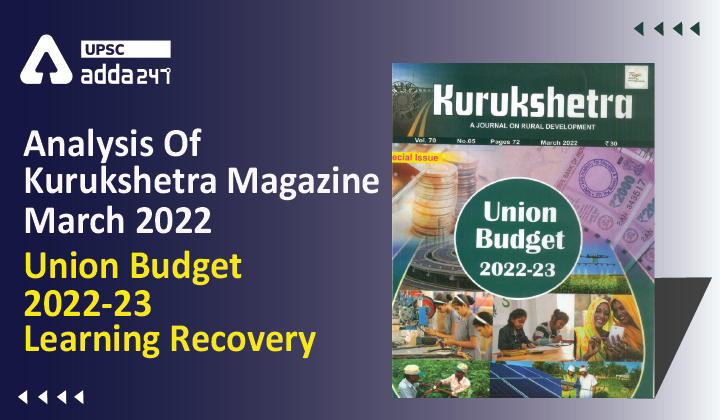Table of Contents
Analysis Of Kurukshetra Magazine :
”Union Budget 2022-23 – Learning Recovery”
Relevance
GS 3: Growth & Development, Planning, Government Budgeting, Inclusive Growth
Introduction
- The years that have gone by, struck by the Covid-19 pandemic, have created a demand for technological advancements in the education sector.
- These considerations are reflected in the Budget to accentuate the learning experience and reduce the gap created by offline schooling.
- While the NEP reiterates the importance of 6% of GDP to the education formula, the previous trend shows that the sector was allocated much lesser in recent years.
- The education budget for 2022-23 has increased by 11.86% from the previous year.
Background
- In a country like ours, where almost 40% of the population is under the employable age, we spend only about 3% of GDP on the education sector.
- Since 1968, the sector has expressed the need for increasing the allocation to 5-6% of the GDP. The realisation needs to factor in that this investment for the future generation is only reaping benefits in terms of a far more educated and equipped youth, ready to take on challenges in every aspect of life.
- Children have witnessed the longest school closures in recent history and were at the receiving end of disruptions in services aiming at basic health, nutrition and child protection services. Thus, the cumulative effect on their overall well-being is likely to be long lasting, unless swift, child-centric measures are taken.
The budget is not in compliance with NEP 2020
- The National Education Policy (NEP) 2020 was launched last year with a huge fanfare. It advocated that 6 per cent of GDP should be allocated to the education sector.
- But, this year’s budget comes down to less than 2 per cent. The education budget may have crossed a landmark of 1 lakh crore but it has been decreasing as a percentage of total expenditure.
Key Provisions
- ‘One class-One TV channel’ programme of PM eVIDYA to be expanded to 200 TV channels. This will enable all states to provide supplementary education in regional languages for classes 1-12.
- Virtual labs and skilling e-labs to be set up to promote critical thinking skills and a simulated learning environment.
- High-quality e-content will be developed for delivery through Digital Teachers.
- The government also announced the creation of a high-quality digital content library for access via all mediums.
- Digital University for world-class quality universal education with a personalised learning experience to be established.
- It also announced a digital university following a hub and spoke model, where the quality educational institutions across the country will collaborate on the project. The best public universities and institutions in the country will collaborate as a network of hub-spoke.
Samagra Shiksha Abhiyan
Also called the National Education Mission, this is India’s biggest school education scheme. This scheme had seen a big reduction in budget allocation last year. This year’s allocation wasn’t able to go back to the level of 2020-21 even after a hike of more than Rs 6000 crores. A loan of USD 500 million has been taken from Asian Development Bank for funding Samagra Shiksha Abhiyan and creating ‘exemplar schools’. Budget allocation for 2022-23: Rs 37,383.36 crores.
Major Concerns
- The budget does not account for the learning losses during the two-and-a-half years of the pandemic.
- Bringing digitisation with no proper thought is dangerous and will create inequalities socially and in terms of educational opportunities.
- Learning through TV cannot substitute classroom teaching but the budget did not focus on teacher training, school infrastructure etc.
- In 2011, the education budget was 11.4 per cent of the total budget, which came down to a low of 10.2 per cent in 2016-17. In 2020-21, it was 10.4 per cent.
Conclusion
Overall, the Budget has set the direction, but a lot needs to be done. Implementation is the key and states must carry the load more than the Centre.



 TSPSC Group 1 Question Paper 2024, Downl...
TSPSC Group 1 Question Paper 2024, Downl...
 TSPSC Group 1 Answer key 2024 Out, Downl...
TSPSC Group 1 Answer key 2024 Out, Downl...
 UPSC Prelims 2024 Question Paper, Downlo...
UPSC Prelims 2024 Question Paper, Downlo...
